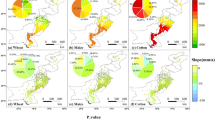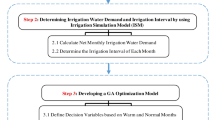Abstract
Due to the widespread uncertainties in agricultural water resources systems and climate change projections, the traditional optimization methods for agricultural water management may have difficulties in generating rational and effective optimal decisions. In order to get optimal future agricultural water allocation schemes for arid areas with consideration of climate change conditions, the model framework established in this paper integrates a statistical downscaling model, back propagation neural networks, and an evapotranspiration model (the Hargreaves model) with inexact irrigation water allocation optimization model under future climate change scenarios. The model framework, which integrates simulation models and optimization models, considers the interactions and uncertainties of parameters, thereby reflecting the realities more accurately. It is applied to the Yingke Irrigation Area in the midstream area of the Heihe River Basin in Zhangye city, Gansu Province, northwest China. Then, water allocation schemes in planning year (2047) under multiple future Representative Concentration Pathways (RCP) scenarios and the status quo (2016) are compared, in order to evaluate the practicability of generated water allocation schemes. The results show that the water shortages of economic crops are improved compared with the status quo under all RCP scenarios while those of the grain crops present opposite results. Meanwhile, the economic benefits decrease from the status quo to planning year under all future scenarios. This phenomenon is directly related to the amount of irrigation water allocation and is indirectly related to the changes of meteorological conditions. The model framework can reveal the regular pattern of hydro-meteorological elements with the impact of climate change. Meanwhile, it can generate irrigation water allocation schemes under various RCPs scenarios which could provide valuable decision support for water resources managers.











Similar content being viewed by others
References
Chen JW, Wu JK (2010) Grain yield and water production efficiency of “rain-water storage and controllable irrigation (RSCI) mode” of rice. J Irrig Drain 29:69–73
Chou SC, Lyra A, Mourão C (2014) Assessment of climate change over South America under RCP 4.5 and 8.5 downscaling scenarios. Am J Clim Change 03:512–527
Chu JT, Xia J, Xu CY (2010) Statistical downscaling of daily mean temperature, pan evaporation and precipitation for climate change scenarios in Haihe River, China. Theor Appl Climatol 99:149–161
Gosling SN, Arnell NW (2016) A global assessment of the impact of climate change on water scarcity. Clim Change 134:371–385
Guo P, Huang GH (2009) Two-stage fuzzy chance-constrained programming: application to water resources management under dual uncertainties. Stoch Environ Res Risk Assess 23:349–359
Huang GH, Baetz BW, Party GG (1992) A grey linear programming municipal solid waste planning under uncertainty. Civ Eng Syst 9:319–335
Huang Y, Li YP, Chen X (2012) Optimization of the irrigation water resources for agricultural sustainability in Tarim River basin, China. Agric Water Manag 107:74–85
IPCC Climate Change (2013) The physical science basis. Cambridge University Press, Cambridge
Jiang Y, Xu X, Huang GH (2016) Optimizing regional irrigation water use by integrating a two-level optimization model and an agro-hydrological model. Agric Water Manag 178:76–88
Li YP, Huang GH, Guo P (2010) Interval-fuzzy possibilistic mixed integer linear programming for environmental management under uncertainty. Int J Environ Pollut 42:107
Li M, Guo P, Fang SQ (2013) An inexact fuzzy parameter two-stage stochastic programming model for irrigation water allocation under uncertainty. Stoch Environ Res Risk Assess 27:1441–1452
Li M, Guo P, Vijay P (2016a) Irrigation water allocation using an inexact two-stage quadratic programming with fuzzy input under climate change. J Am Water Resour Assoc 1:1
Li M, Guo P, Singh VP (2016b) An efficient irrigation water allocation model under uncertainty. Agric Syst 144:46–57
Li M, Guo P, Singh VP (2016c) Biobjective optimization for efficient irrigation under fuzzy uncertainty. J Irrig Drain Eng 62:1
Liu Z, Xu Z (2015) Climate change scenarios generated by using GCM outputs and statistical downscaling in an arid region. Desert 20:101–115
Lu HW, Huang GH, He L (2010) Development of an interval-valued fuzzy linear-programming method based on infinite α-cuts for water resources management. Environ Modell Softw 25:354–361
Mccarthy JJ, Canziani OF, Leary NA (2007) Impacts, adaptation, and vulnerability. J Environ Qual 1:37
Mi XC, Ma KP, Zou YB (2005) Artificial neural network and its application in agricultural and ecological research. Acta Ecol Sin 25:863–870
Pan YH, Zhang H, Ma JZ (2012) Quantities research of climate change and human activities affecting water resources. Yellow River 34:55–56
Pierce DW, Barnett TP, Santer BD (2009) Selecting global climate models for regional climate change studies. Proc Natl Acad Sci USA 106:8441–8446
Ruan BQ, Liang RJ, Chen SJ (2000) A method for risk analysis and evaluation of water supply and demand. J Hydraul Eng ASCE 9:1–7
Shukla R, Khare D (2015) Statistical downscaling of climate change scenarios of rainfall and temperature over Indira Sagar Canal Command area in Madhya. In: IEEE 14th international conference on machine learning and applications
Tang XP, Song N, Chen ZF (2016) Spatial and temporal distribution of ET0 under main climate scenarios in future across Huang-Huai-Hai Plain. Trans Chin Soc Agric Eng 32:168–176
Teutschbein C, Grabs TRH, Karlsen H (2015) Hydrological response to changing climate conditions: spatial streamflow variability in the Boreal Region. Water Resour Res 51:9425–9446
Tong FF, Guo P (2013) Simulation and optimization for crop water allocation based on crop water production functions and climate factor under uncertainty. Appl Math Model 37:7708–7716
Van DP, Edmonds J (2011) The representative concentration pathways: an overview. Clim Change 105:5–31
Wang YM, Yu XJ, Chang JX (2008) Prediction of runoff based on BP neural network and Markow model. Eng J Wuhan Univ 41:15–57
Yang GQ, Guo P, Li M (2016) An improved solving approach for interval-parameter programming and application to an optimal allocation of irrigation water problem. Water Resour Manag 30:701–729
Zhang CL, Guo PZ (2017) An inexact CVaR two-stage mixed-integer linear programming approach for agricultural water management under uncertainty considering ecological water requirement. Ecol Indic 1:1–12
Zhang B, Wang HQ, Zhang H (2009) The simulation and prediction of monthly runoff in Yingluoxia based on artificial neural network. J Nat Resour 24:2169–2177
Zhang LP, Zeng SD, Wang RC (2011) Impacts of climate change on the hydrological cycle in the Luan River basin. Resour Sci 33:966–974
Zhao TB, Fu CB (2006) Preliminary comparison and analysis between ERA-40, NCEP-2 reanalysis and observations over China. Clim Environ Res 11:15–32
Zhuang XW, Li YP, Nie S (2018) Analyzing climate change impacts on water resources under uncertainty using an integrated simulation–optimization approach. J Hydrol 556:523–538
Acknowledgements
This study was financially supported by the National Key Research and Development Program of China (No. 2016YFC0400207) and National Natural Science Foundation of China (No. 51621061).
Author information
Authors and Affiliations
Corresponding author
Rights and permissions
About this article
Cite this article
Wang, Y., Liu, L., Guo, P. et al. An inexact irrigation water allocation optimization model under future climate change. Stoch Environ Res Risk Assess 33, 271–285 (2019). https://doi.org/10.1007/s00477-018-1597-y
Published:
Issue Date:
DOI: https://doi.org/10.1007/s00477-018-1597-y




